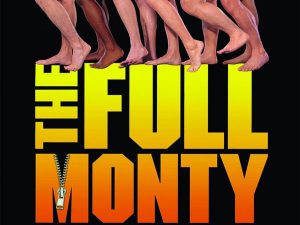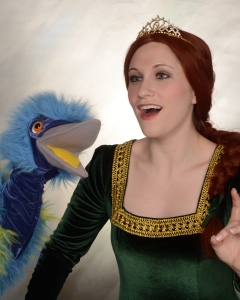By Jennifer L. Gusso

Approx. Running Time: 2 hours and 30 minutes with one intermission.
Every so often, a production comes around where every element works perfectly and transcends to a level of sheer theater magic. One of those productions is the Tidewater Players’ current production of The Full Monty with Book by Terrence McNally and Music & Lyrics by David Yazbek, Directed by Laurie Starkey, with Music Direction by R. Christopher Rose, and Choreography by Elise Starkey. If you don’t already have tickets to this hysterical and heartwarming delight, you should buy them immediately. This cast and production team consistently deliver in bringing to life one of the funniest scripts in Musical Theater.

The Cast of The Full Monty at Tidewater Players. Credit: Tidewater Players
Fair warning: This is the tale of a group of out-of-work steel workers who have decided to make some money by taking off all their clothes. There will be some skin, combined with language and other adult themes, that does make this production not appropriate for young audiences. However, mature teens and even the most conservative adults are unlikely to be offended, as this is not skin for the sake of skin – this is a story about loving yourself and about body acceptance. It has a strong moral foundation and excellent themes about what it means it be a “Man.”
Director Laurie Stentman Starkey’s curtain speech talked about her great love for this piece and her desire to really do justice to the message of this show. That love shows in every detail of this production. From assembling a dynamic cast to effective staging, quick scene changes, and seamless integration of technical aspects, a strong and skilled directorial hand is evident throughout. Her vision is furthered with strong musical leadership at the hands of R. Christopher Rose. Both soloists and ensembles shine consistently in their knowledge of the music and how to deliver the music for maximum impact. Another shining star is the choreography of Elise Starkey. Her choreography is not only eye-catching and delivered with stunning synchronicity, it also often tells the story and adds to the humor.
The technical aspects are also very well-designed and effective. Laurie Starkey & Todd Starkey create a set design that easily transforms into a variety of locales, ending in the amazing culmination of the “Full Monty” sign in the closing scenes. The lighting design by Thomas Gardner adds depth and character throughout and works perfectly in the most crucial of moments. Costume Design by Eva Grove is clever and detailed. Like the other aspects, it highlights the two key aspects of this production: character and humor.
With these things in place, the cast is set up for success, and they take that ball and run with it. There is truly not a weak link in the entire ensemble. The thing that works so brilliantly is that the production team and cast really got the characters and the theme of the piece. What makes this show both funny and touching is that these are real men stepping outside of their comfort zone. The characters are quirky and zany at times, but, above all else, they are real. It is only in playing these characters as real and complex and not over-the-top that this show can truly work. Starkey and her cast understand this and instead of trying to play for laughs or manipulate audience emotion, they allow themselves to be real characters who experience this story as it unfolds. The result is that the audience laughs and cries and falls in love with the vulnerability and reality on display in front of them.
The cast also melds together so well as an ensemble that is practically impossible to single out and talk about these performances as individuals. They are always working as a team, reacting and supporting as much as taking the spotlight. The supporting characters are just as real as the leads and played by some equally strong actors. With just a few small scenes, Matt Peterson allows the audience to see things from Teddy’s side, as much as we may be inclined to dislike him. The same is true of Angie Sokolov as Pam. It’s tough to play characters that are standing in opposition to the protagonist. Sokolov allows us to see Pam’s point of view in way that lets us feel OK about rooting for her happiness as well. Another strength in the supporting characters can be seen in Samantha Jednorski’s portrayal of Estelle. She finds ways to build layers and depths with her reactions that create a real person and not a one-dimensional cliché. Audiences will also definitely remember the supporting performance of Wayne Ivusich (Rev. Willoughby/Minister) who almost bares it all with zeal in one of his several standout comedic moments.
Two actresses that definitely deserve some individual attention are Barbara Snyder (Jeanette Burmeister) and Lisa Pastella (Georgie Bukatinsky). Snyder consistently brings joy and laughter to the audience with her feisty character and solid comedic delivery, and Pastella easily has one of the best female voices in the local theater community. Pastella also has incredible chemistry with her onstage husband and creates a character who is vibrant and believable.
However, at the end of the day, this show is truly about the six men who decide to bare it all. These six men forge an incredible bond on stage that is the foundation of this show, while each creating unique and loveable characters. Austin Barnes (Ethan Girard) sparkles with optimism and heart. Ethan is a character that could easily be overplayed, but Barnes finds the reality in his constant belief that he can do impossible things. Balancing Ethan’s often misguided optimism is Malcolm’s often misguided pessimism. As Malcolm, Josh Schoff finds the balance and the lightness in his conflicted character. The onstage chemistry between Barnes and Schoff is also impressive, as they say so much through simple looks and gestures and tiny moments that slowly build. During “You Walk With Me,” Barnes and Schoff, in beautiful harmony, make the audience’s hearts both break and swell with them.
Adding to the dynamic group of gentlemen is Steve Flickinger as Harold Nichols. Flickinger has stellar comedic timing and the most priceless facial reactions. Then, there is Lamar Leonard as Noah “Horse” Simmons with his smooth dance moves, sweet vocals, and comedic calisthenics. He lights up the entire room with his performance of “Big Black Man.” Like so much of the cast, Flickinger and Leonard balance all of these crazy comedic moments with vulnerability. Both men have these touching, small moments in which we see the fears and real person inside. This group of men is so unafraid to be exposed on stage – emotionally and mentally as well as physically that the audience leaves feeling like it is a group of old friends.

The Cast of The Full Monty at Tidewater Players. Credit: Tidewater Players
The cornerstone of old friends, with such a believable onstage dynamic that you feel like they must truly be old friends, are Dave Bukatinsky (Mark Lloyd) and Jerry Lukowski (Jake Stuart). Everything that this production does well is crystallized in the amazing performances by these two gentlemen. Lloyd has these moments like “You Rule My World” or wrapped in Saran Wrap, where he shows the audience Dave’s fears and insecurities and pains despite the fact that everyone is laughing. He does an excellent job of living those moments rather than trying to chase the cheap humor. The audience laughs at him, but knowing that we are laughing at him also builds a deep empathy for everything that Dave struggles with. It is empowering and a testament to Lloyd’s strong character development to watch Dave slowly gain confidence and sense of self throughout the piece. Ultimately, though, the heart of the show is its unconventional protagonist Jerry, and Stuart gives the most impressively real portrayal. There is not a single moment where it feels like he is acting or pretending. Every line, every action, and every reaction feels real and genuine and in the moment. He creates the most believable, flawed, and loveable man, and it just feels natural. A beautiful example of Lloyd and Stuart together is “Big-Ass Rock.” The song is hilarious. The vocals are gorgeous. The harmonies are solid. Right beneath the surface, though, is real pain and real men. We get to know them. We get to love them. In many ways, we are them.
When Starkey talked in her curtain speech about the powerful and important theme of this show, she touched on something that was then brought to life for her audience. The Full Monty is about real people – people with insecurities and flaws and quirks and weaknesses – people who succeed sometimes and fail other times – people who are victims to external things they can’t control and internal things that they can control. The Full Monty shows how real people can learn to love themselves and each other despite all of that – despite our own flaws, despite others’ flaw, despite an imperfect world – an imperfect world which is perfectly represented in this flawless production that should top everyone’s to-do list within the next two weekends.
This is what I thought of Tidewater Players’ production of The Full Monty… What did you think? Please feel free to leave a comment!
The Full Monty will play through May 19 at Tidewater Players at The Cultural Center at the Opera House, 121 N. Union Street, Havre de Grace, MD. Purchase tickets at the door one hour before show time or purchase them online.
Email us at backstagebaltimore@gmail.com
Like Backstage Baltimore on Facebook, and follow us on Twitter and Instagram!







 Slithering onto the stage on their matching scooters were Josh Schoff as Flotsam and Jonah Wolf as Jetsam. The choice of scooters to maneuver them around stage was inventive and paid off in execution. Both actors were able to skillfully incorporate them in their character and not rely on them as a crutch. They were perfect henchmen to Holly Gibbs’ Ursula. Having arguably both the best and worst songs in the show, Ms. Gibb was able to make the most of her voice and complemented with acting ability that emanated from all eight limbs.
Slithering onto the stage on their matching scooters were Josh Schoff as Flotsam and Jonah Wolf as Jetsam. The choice of scooters to maneuver them around stage was inventive and paid off in execution. Both actors were able to skillfully incorporate them in their character and not rely on them as a crutch. They were perfect henchmen to Holly Gibbs’ Ursula. Having arguably both the best and worst songs in the show, Ms. Gibb was able to make the most of her voice and complemented with acting ability that emanated from all eight limbs.








